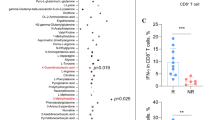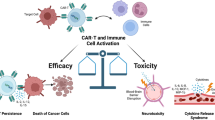Abstract
Caspase-independent cell death may have a critical role to play in the therapeutic destruction of tumours. Recently it has been suggested that one of the mechanisms by which rituximab, a therapeutic anti-CD20 antibody, kills B cells is caspase-independent. In this study we show that rituximab can induce death in a variety of Burkitt lymphoma derived cell lines. Rituximab-treated cells show leakage of adenylate kinase, surface expression of phosphatidylserine, upregulation of the cellular stress protein HSP70, phosphorylation of the survival protein Akt, and depolarisation of the mitochondrial membrane but no loss of cytochrome c or apoptosis inducing factor. Caspase inhibitors do not block these events. In support of these data there is no cleavage of caspases 3, 8 and 9, poly(ADP-ribose) polymerase, BH3 interacting domain death agonist or genomic DNA. Morphologically, cells show nuclear enlargement and cytoplasmic vacuolisation. Triggering of receptor mediated death in CD95 responsive lines results in “classical” apoptosis indicating that the internal machinery necessary for apoptosis is intact in these lines. The results suggest that rituximab can kill human B cells via a caspase-independent form of programmed cell death that shares features of apoptosis and necrosis. This pathway may be relevant to the clinical efficacy of rituximab.
Article PDF
Similar content being viewed by others
References
Kirchner EM, Ebsen M, Kirchner J, Theegarten D, Voigtmann R. Transformation of Hodgkin’s disease to high-grade B-cell lymphoma: Remission after Rituximab monotherapy. Ann Oncol 2001; 12: 1169–1171.
Maloney DG, Grillo-Lopez AJ, White CA, et al. IDEC-C2B8 (Rituximab) anti-CD20 monoclonal antibody therapy in patients with relapsed low-grade non-Hodgkin’s lymphoma. Blood 1997; 90: 2188–2195.
Liu AY, Robinson RR, Murray ED, Jr., Ledbetter JA, Hellstrom I, Hellstrom KE. Production of a mouse-human chimeric monoclonal antibody to CD20 with potent Fc-dependent biologic activity. J Immunol 1987; 139: 3521–3526.
Flieger D, Renoth S, Beier I, Sauerbruch T, Schmidt-Wolf I. Mechanism of cytotoxicity induced by chimeric mouse human monoclonal antibody IDEC-C2B8 in CD20-expressing lymphoma cell lines. Cell Immunol 2000; 204: 55–63.
Golay J, Zaffaroni L, Vaccari T, et al. Biologic response of B lymphoma cells to anti-CD20 monoclonal antibody rituximab in vitro: CD55 and CD59 regulate complement-mediated cell lysis. Blood 2000; 95: 3900–3908.
Cragg MS, Glennie MJ. Antibody specificity controls in vivo effector mechanisms of anti-CD20 reagents. Blood 2003.
Manches O, Lui G, Chaperot L, et al. In vitro mechanisms of action of rituximab on primary non-Hodgkin’s lymphomas. Blood 2002; 3: 3.
Shan D, Ledbetter JA, Press OW. Apoptosis of malignant human B cells by ligation of CD20 with monoclonal antibodies. Blood 1998; 91: 1644–1652.
Shan D, Ledbetter JA, Press OW. Signaling events involved in anti-CD20-induced apoptosis of malignant human B cells. Cancer Immunol Immunother 2000; 48: 673–683.
Mathas S, Rickers A, Bommert K, Dorken B, Mapara MY. Anti-CD20- and B-cell receptor-mediated apoptosis: Evidence for shared intracellular signaling pathways. Cancer Res 2000; 60: 7170–7176.
van der Kolk LE, Evers LM, Omene C, et al. CD20-induced B cell death can bypass mitochondria and caspase activation. Leukemia 2002; 16: 1735–1744.
Chan HT, Hughes D, French RR, et al. CD20-induced lymphoma cell death is independent of both caspases and its redistribution into triton X-100 insoluble membrane rafts. Cancer Res 2003; 63: 5480–5489.
Bellosillo B, Villamor N, Lopez-Guillermo A, et al. Complement-mediated cell death induced by rituximab in B-cell lymphoproliferative disorders is mediated in vitro by a caspase-independent mechanism involving the generation of reactive oxygen species. Blood 2001; 98: 2771–2777.
Mathiasen IS, Jaattela M. Triggering caspase-independent cell death to combat cancer. Trends Mol Med 2002; 8: 212–220.
Assuncao Guimaraes C, Linden R. Programmed cell deaths. Apoptosis and alternative deathstyles. Eur J Biochem 2004; 271: 1638–1650.
Vier J, Furmann C, Hacker G. Baculovirus P35 protein does not inhibit caspase-9 in a cell-free system of apoptosis. Biochem Biophys Res Commun 2000; 276: 855–861.
Stennicke HR, Deveraux QL, Humke EW, Reed JC, Dixit VM, Salvesen GS. Caspase-9 can be activated without proteolytic processing. J Biol Chem 1999; 274: 8359–8362.
Pepper C, Thomas A, Tucker H, Hoy T, Bentley P. Flow cytometric assessment of three different methods for the measurement of in vitro apoptosis. Leuk Res 1998; 22: 439–444.
Bradbury DA, Simmons TD, Slater KJ, Crouch SP. Measurement of the ADP:ATP ratio in human leukaemic cell lines can be used as an indicator of cell viability, necrosis and apoptosis. J Immunol Methods 2000; 240: 79–92.
Renz A, Berdel WE, Kreuter M, Belka C, Schulze-Osthoff K, Los M. Rapid extracellular release of cytochrome c is specific for apoptosis and marks cell death in vivo. Blood 2001; 98: 1542–1548.
Johnson BW, Cepero E, Boise LH. Bcl-xL inhibits cytochrome c release but not mitochondrial depolarization during the activation of multiple death pathways by tumor necrosis factor-alpha. J Biol Chem 2000; 275: 31546–31553.
Cregan SP, Fortin A, MacLaurin JG, et al. Apoptosis-inducing factor is involved in the regulation of caspase-independent neuronal cell death. J Cell Biol 2002; 158: 507–517.
Cande C, Cecconi F, Dessen P, Kroemer G. Apoptosis-inducing factor (AIF): Key to the conserved caspase-independent pathways of cell death? J Cell Sci 2002; 115: 4727–4734.
Anether G, Tinhofer I, Senfter M, Greil R. Tetrocarcin-A–induced ER stress mediates apoptosis in B-CLL cells via a Bcl-2–independent pathway. Blood 2003; 101: 4561–4568.
Mone AP, Huang P, Pelicano H, et al. Hu1D10 induces apoptosis concurrent with activation of the AKT survival pathway in human chronic lymphocytic leukemia cells. Blood 2004; 103: 1846–1854.
Carew JS, Nawrocki ST, Krupnik YV, et al. Targeting endoplasmic reticulum protein transport: A novel strategy to kill malignant B cells and overcome fludarabine resistance in CLL. Blood 2005.
Casiano CA, Ochs RL, Tan EM. Distinct cleavage products of nuclear proteins in apoptosis and necrosis revealed by autoantibody probes. Cell Death Differ 1998; 5: 183–190.
Miyazaki K, Yoshida H, Sasaki M, et al. Caspase-independent cell death and mitochondrial disruptions observed in the Apaf1-deficient cells. J Biochem 2001; 129: 963–969.
Rose AL, Smith BE, Maloney DG. Glucocorticoids and rituximab in vitro: Synergistic direct antiproliferative and apoptotic effects. Blood 2002; 100: 1765–1773.
Kim TH, Zhao Y, Barber MJ, Kuharsky DK, Yin XM. Bid-induced cytochrome c release is mediated by a pathway independent of mitochondrial permeability transition pore and Bax. J Biol Chem 2000; 275: 39474–39481.
Shimizu S, Tsujimoto Y. Proapoptotic BH3-only Bcl-2 family members induce cytochrome c release, but not mitochondrial membrane potential loss, and do not directly modulate voltage-dependent anion channel activity. Proc Natl Acad Sci USA 2000; 97: 577–582.
Johnson DE. Noncaspase proteases in apoptosis. Leukemia 2000; 14: 1695–703.
Egger L, Schneider J, Rheme C, Tapernoux M, Hacki J, Borner C. Serine proteases mediate apoptosis-like cell death and phagocytosis under caspase-inhibiting conditions. Cell Death Differ 2003; 10: 1188–1203.
Lockshin RA, Zakeri Z. Caspase-independent cell deaths. Curr Opin Cell Biol 2002; 14: 727–733.
Author information
Authors and Affiliations
Corresponding author
Rights and permissions
About this article
Cite this article
Daniels, I., Abulayha, A.M., Thomson, B.J. et al. Caspase-independent killing of Burkitt lymphoma cell lines by rituximab. Apoptosis 11, 1013–1023 (2006). https://doi.org/10.1007/s10495-006-6314-5
Published:
Issue Date:
DOI: https://doi.org/10.1007/s10495-006-6314-5




